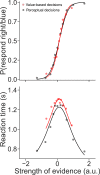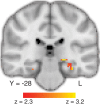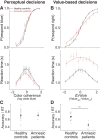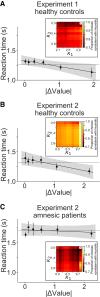The hippocampus supports deliberation during value-based decisions
- PMID: 31268419
- PMCID: PMC6693920
- DOI: 10.7554/eLife.46080
The hippocampus supports deliberation during value-based decisions
Abstract
Choosing between two items involves deliberation and comparison of the features of each item and its value. Such decisions take more time when choosing between options of similar value, possibly because these decisions require more evidence, but the mechanisms involved are not clear. We propose that the hippocampus supports deliberation about value, given its well-known role in prospection and relational cognition. We assessed the role of the hippocampus in deliberation in two experiments. First, using fMRI in healthy participants, we found that BOLD activity in the hippocampus increased as a function of deliberation time. Second, we found that patients with hippocampal damage exhibited more stochastic choices and longer reaction times than controls, possibly due to their failure to construct value-based or internal evidence during deliberation. Both sets of results were stronger in value-based decisions compared to perceptual decisions.
Keywords: Amnesia; decision making; fMRI; hippocampus; human; neuroscience.
Conflict of interest statement
AB, DP, AZ, YK, AR, MV, MS, DS No competing interests declared
Figures


















Comment in
-
Remembering to choose the future.Elife. 2019 Aug 14;8:e49828. doi: 10.7554/eLife.49828. Elife. 2019. PMID: 31411563 Free PMC article.
References
-
- Bakkour A. MDMRT_scan. 8e89da1GitHub. 2019 https://github.com/abakkour/MDMRT_scan
Publication types
MeSH terms
Grants and funding
- VA Senior Research Career Scientist Award/U.S. Department of Veterans Affairs/International
- VA Senior Research Career Scientist Award & VA Merit Grant CX001748/U.S. Department of Veterans Affairs/International
- McKnight Memory and Cognitive Disorders Award/McKnight Foundation/International
- NEI grant T32-EY013933/EY/NEI NIH HHS/United States
- 1606916/National Science Foundation/International
- NIH grant # R01EY011378/NH/NIH HHS/United States
- I01 CX001748/CX/CSRD VA/United States
- NSF grant #1606916/National Science Foundation/International
- R01EY011378/NH/NIH HHS/United States
- HHMI Investigator/HHMI/Howard Hughes Medical Institute/United States
- VA Merit Grant CX001748/U.S. Department of Veterans Affairs/International
- T32-EY013933/EY/NEI NIH HHS/United States
LinkOut - more resources
Full Text Sources
Other Literature Sources

